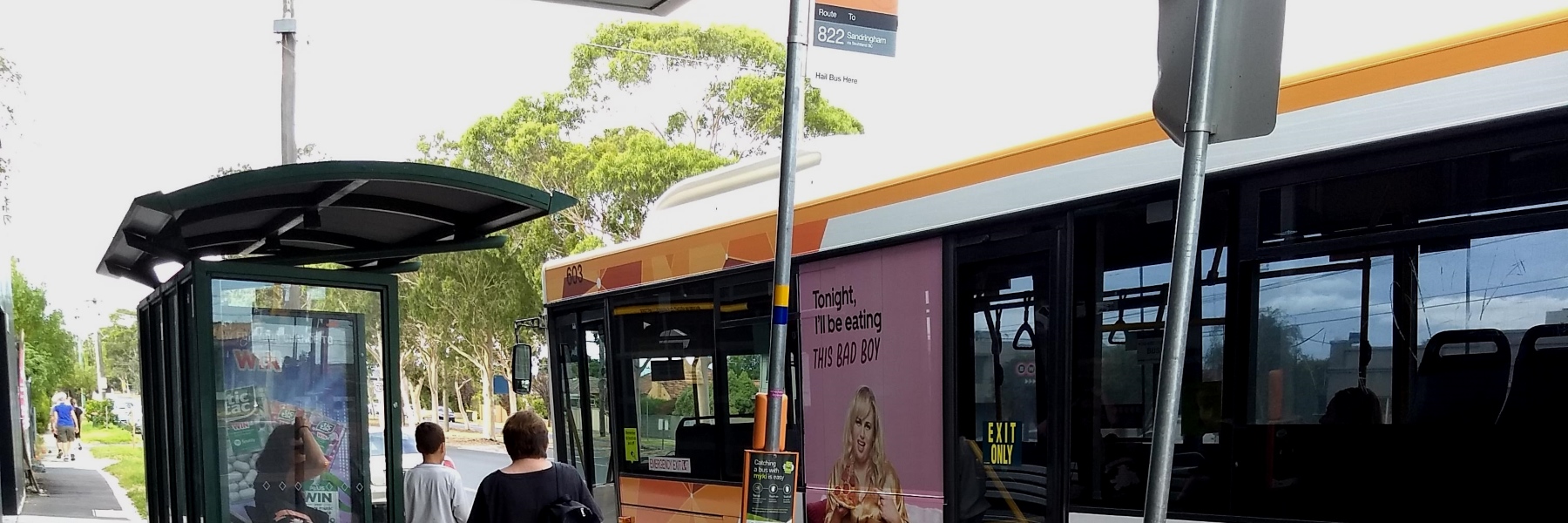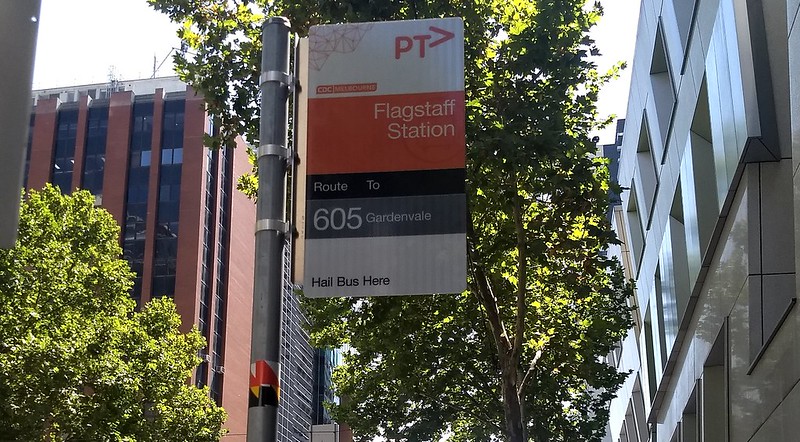Sometimes I notice tiny things, and wonder what they’re about.
Have you noticed that some bus stops have a small colourful stripy bit of tape?
Intriguingly, many of them seem to match the colours of the logo of the bus operator for that route – even if the buses themselves are now all in the standard PTV orange livery.
Here’s one on a Ventura route (blue and yellow):
I should have guessed it, but a well-informed Twitterer had the answer:
They’re timing points. Spots along the route where the bus driver needs to check their timetable and may need to wait if they’re early.
Many of them seem to be at major stops such as railway stations, though some are not.
This raises another topic: with many level crossings being removed, which cuts delays along bus routes (particularly highly variable, unpredictable delays), are bus timetables being re-written?
It appears not. A few weeks ago I caught a southbound route 626 bus at Carnegie station that arrived at the stop almost five minutes early. And that was in the PM peak.
The 626 timetable still allows 8 minutes for the 850 metres between Chestnut Street/Dandenong Road (the stop before the station) and Koornang/Neerim Roads (the stop after the station).
Its sister route 623 is the same. You could (briskly) walk it in eight minutes.
Back when the level crossing was there, it probably made sense to allow that much time. Not so much now.
As level crossing removals proceed across Melbourne, authorities should be reviewing bus timetables and taking the reduced delays into account.
After all, speeding up street-based public transport is one of the key non-motorist benefits of grade separation.
Timetable tweaks may not be enough to run extra services with the same buses, but they can at least help cut unnecessary delays – particularly for bus passengers not boarding or alighting at those timing points.




7 replies on “Bus stop stripes”
Early January I caught a 630 from Gardenvale to Huntingdale. The driver correctly waited at Ormond station for a few minutes. I alighted one stop before the next timing point at Huntingdale station 7 minutes early.
You make a good point. But I would give priority to ensuring that the timetable showing at the stop is the current one and legible. And also to repairing or replacing the glass and seating at bus shelters that have been damaged during road works or by an accident.
Neither of these has been done at the 510 bus stop at the NE corner of Holmes Street and Moreland Road (well, after a considerable delay, there are now seats but no glass).
Isn’t one if the outcomes of the 2018 process to purchase bus routes back from “the family companies who own them” supposed to be about restructuring routes and timetables. Does anyone know if the contract negotiations have been completed? Or if the threatened legal action by smaller operators occured/is ingoing. Does not seem to be much coverage of this in the media since the middle if last year.
Greg Fisher you make a good point.
Until the timetables are rewritten, a simple immediate gain would be to use the extra time to delay the departure from the timing stop (especially if it is a transit station) immediately before the removed crossing. For example, said 626 could wait longer at Chaddy (to account for the removed crossing at Koornang) and leave a little later from Carnegie Station (to account for the removed crossing at McKinnon).
Then again it doesn’t matter if the timetables are not enforced. I once saw an empty 822 rush out two minutes early when they saw a rush of people coming out of the (old) station.
Are the bus companies incentivised based on number of passengers carried or on delays? If they leave early from a timed stop do they get a penalty?
I guess, with some routes such as #703, they where waiting for two grade separations to happen before they did a re-do of the timetable. Make all of the changes at once.
If you count the time savings with two major crossings gone, especially with the old 627 with four on its route gone, would it now be possible to remove one bus from service. Operate the same frequency with fewer buses in service?
Or, in line with Greg Fisher, are they waiting for a complete rewrite of the whole bus network, and are holding off on any changes until that was done?
I too, would value updated advice in respect to the bus route buyback.
Bus timetables are assessed and rewritten every year. Just not the majority of them at any one time. When you start looking at how services interact it can be like pulling threads. You pull on one or two and all of a sudden your sweater is a pile of yarn on the ground. Bus timetable updates tend to be major affairs and are rarely done in any scale more than annually (and far less frequently on an individual route basis)
I can only imagine that there are some pretty involved conversations at DoT and PTV about current and future train line upgrades, about the impact on people’s lives because of the constant cycles of disruptions and the cost-benefit analysis of further changes to timetables at any particular moment (both in financial and emotional terms), as well as whether it is worth making changes now, or after the next train upgrade or the next after that…